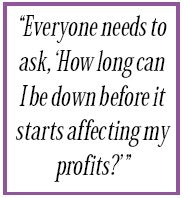A Recovery Plan Must Be in Place Before Disaster Strikes

You arrive at work one morning to find your building in flames. The fire department is doing its best to hose down the structure, but it's apparent nothing will be left. Your inventory, your equipment, your business records - all gone. Your employees are standing around, stunned.
Now what?
This experience can happen to anyone - and it needn't be an all-out tragedy such as a flood, hurricane or tornado. Fires, windstorms and power failures - with their resulting data loss - can also strike at any time.
In the worst cases, businesses fold. But financial losses can be severe even for those that manage to stay afloat. The loss of accounts receivable information, for example, means businesses don't know who owes them money. Following the most devastating disasters, even clubs that vow to rebuild will likely lose members permanently to other nearby for-profit fitness and recreation centers.
Recent calamities have put this issue on the front burner for many businesspeople. "Disaster planning was once seen as an overhead and insurance situation," says Richard L. Arnold, founder of the St. Louis-based Disaster Recovery Institute, which conducts seminars on the topic. "But in recent years, there have been enough natural disasters that business owners view it as a necessity and auditors view it as prudent planning."
According to Arnold, every business owner needs a disaster recovery plan: "Everyone needs to ask, 'How long can I be down before it starts affecting my profits?' "
While the following steps will help owners get a disaster recovery plan in place, the details are best fleshed out with the active participation of a club's accountant and attorney.
1. GATHER CRITICAL INFORMATION. When disaster strikes, it's too late to think about gathering information from sources that have been destroyed. Now is the time to create the information resources you'll need in a time of crisis. "Start by putting together your databases of information," says Jeffrey Williams, president of Binomial International, a disaster planning consultancy in Ogdensburg, N.Y. "In deciding what data to include, imagine yourself trying to run your business from a phone booth. Then make a list of the contacts you will need to call." Paramount, of course, will be lists of club members and staff members. These may already be in a database that can be backed up; otherwise, you will need to create a file of names, addresses and phone numbers.
Once that's done, put together a list of "emergency responders." These are individuals you will need to call to get your show back on the road. Here are some examples:
• Attorneys, accountants and insurance representatives.
• Service firms that can accomplish tasks such as removing water from the premises, repairing damaged courts and fitness equipment, removing rubbish, repainting, repairing electrical and plumbing systems, replacing locks and repairing and installing data processing systems.
• Real estate agencies that may assist in establishing an alternative base of operations while restorations continue.
Make copies of all of the above data and store them off-site in a safe deposit box or in your home.
2. ASSIGN DUTIES. "Things will go much smoother if everyone knows what they ought to do in a crisis," says Williams. Based on the data you've accumulated, assign tasks such as the following:
• Calling all staff members to let them know what has happened.
• Notifying suppliers and insurance companies.
• Arranging for repair work by plumbers, electricians and restoration contractors.
You should decide on an office in which to conduct recovery operations. This may be your home or another place away from the main business. A copy of your emergency phone number list and your recovery plan should be kept at this location. Have a computer system in place into which the latest data can be installed. Under the best of conditions, this computer would be updated regularly with business data.
3. MAINTAIN THE PLAN. Don't just write the plan once and put it on the shelf. "Every six to 12 months, review your plan to make sure it's up-to-date," says Williams. "People change. Either they leave the organization or they get new phone numbers." You don't want to be stumbling through flood waters looking for current information.
No matter how carefully you plan, there will be some substantial impact on your cash flow and profits in the event of a disaster. Draw up an estimate of the impact, by number of days of suspended operations. Ask the following questions: What inroads will be made by your competitors who can pursue your current members? What will be the daily impact on your cash flow? How will a disaster affect your ability to deliver services? How much will it cost to get yourself back up and running?
Most businesses find that standard insurance packages are insufficient in dire times. Fire insurance, for example, won't pay for the loss of revenue streams while you are waiting to rebuild.
"If you have a fire, your property insurance will typically pay for rebuilding, but not for the other expenses you will incur to continue in business," says Don Griffin, director of business and personal lines at the National Association of Independent Insurers in Des Plaines, Ill.
It's for this reason that business interruption insurance (typically six months worth) can be a critical part of keeping businesses in operation while they recover from a disaster. Such insurance covers loss of business income and reimburses necessary expenses when a natural disaster forces businesses to completely suspend operations. Business interruption insurance will cover such expenses as ongoing payroll, phone bills, rent, electricity and reinstallation of phone and computer systems. Your commercial property insurance policy may already include compensation for business interruption; if not, you will need to have a rider attached or seek coverage from another carrier.
Additional information about contingency planning is available from the Disaster Recovery Institute (www.dr.org/ uselink.htm). Phoenix Disaster Recovery Planning System, a computer program for disaster planning, may be obtained from Binomial International (www.binomial.com). In addition, Alan M. Levitt's book, Disaster Planning and Recovery: A Guide for Facility Professionals (John Wiley & Sons, 1997), shows how to prepare for, cope with and recover from a variety of disasters.
































